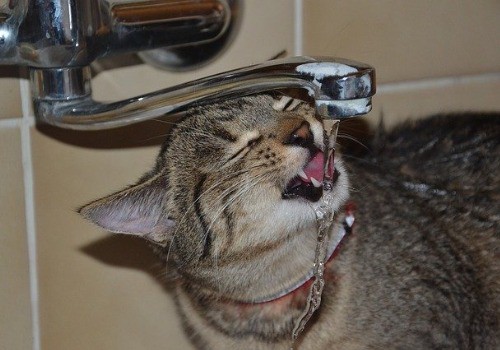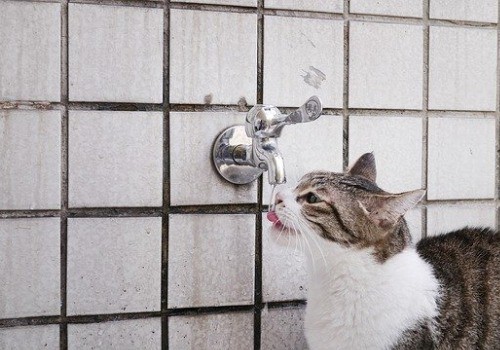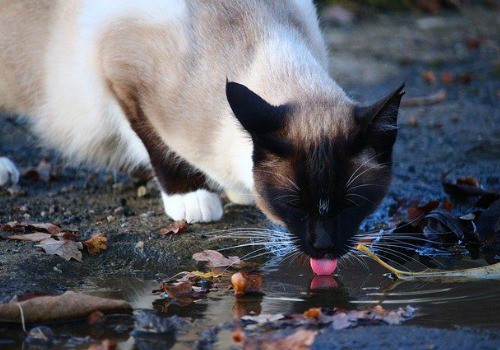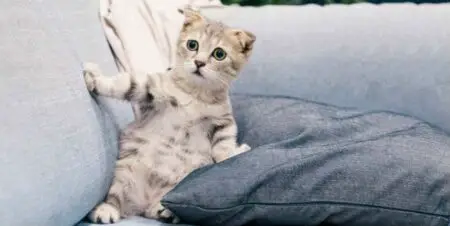The average domestic cat will normally expel urine two to four times every 24 hours, but the key word here is “average.” The animal’s size and fluid intakes, along with certain disease processes, have a bearing on how often it pees in a day. The item to remember is that cat urine is extremely concentrated; a 24-hour routine should yield about half a cup from a ten-pound cat.
Cats, after all, are desert creatures, with their wild ancestors living in the arid regions of the Middle East. Their bodies evolved accordingly over the last 9,500 years, featuring a smaller bladder and urethra, or the duct by which the urine is discharged. Those who support this theory argue that the fluids from the average small bird are enough to quench a cat’s natural thirst.
The ten-pound cat should drink seven to nine ounces of water a day, although it can get along with less if its food is wet (a can of wet cat food is 70 to 80 percent water). But in cats, the resultant urine is more than a waste product. The cats use it to mark their territories and announce they’re available to mate, and vets examine it to find disease.
The practitioners also note that one bacterium in the water can multiply to 38,000 in 48 hours after a single sip.
Water Good for What Ails the Urinary Tract

Drinking water doesn’t directly produce urine, but it does optimize the urinary tract’s efficiency. The water that mammals drink goes through the digestive tract and is absorbed into the bloodstream. The kidneys, which are part of the renal system, or urinary tract, filter the blood.
[amazon bestseller=”cats uti treatment”]
Cat pee contains about 95 percent water and 2 percent urea, a waste product resulting from protein metabolism. It’s also made up of trace amounts of chloride, sulfate, phosphate, sodium, creatinine, ammonia and uric acid. Normal cat urine is clear and yellow, while medications can cause it to turn blue or other colors.
Urine turns dark red or brown with the presence of blood, and liver problems produce green, yellow-brown or foamy urine.
Felinine Is the Culprit Behind the Odor
Cats are carnivores, the website Catster says; as such, cat urine contains an amino acid called felinine. Felinine is odorless to humans, but it eventually breaks down into sulfur-containing compounds that produce ammonia-like odors. Nonneutered males produce about three times more of it than neutered males or females, because testosterone regulates felinine excretion.
Cat pee odors, the site says, are difficult to remove for two reasons. The first is that cats have a superior sense of smell, so they will be able to pick up on the pheromones left behind from the felinine that humans cannot detect. Regular cleaners also do not eliminate these sulfur-containing compounds, and cats will continue to mark their turf if the odor isn’t completely eliminated.
The cat’s diet may also be responsible for the urine’s ammonia smell, which is exacerbated by wood, corncob or paper-based litter.
In mammals, the urinary tract consists of two kidneys, which filter blood and produce urine; two ureters, which carry the urine to the bladder; the bladder, which holds the urine; and the urethra, a tube through which urine flows from the bladder and leaves the body.
[amazon bestseller=”Cats litter box”]
Diabetes May Be Behind Urine Volume

When the kidneys don’t work correctly, waste products can enter the blood, compromising the other vital organs and cause severe and even fatal illness. If your cat produces too little urine, that could indicate dehydration, kidney failure or a urinary blockage. If your cat produces too much urine, diabetes or other illness might be the culprit.
Dehydration symptoms include excessive drooling, panting, ulcers, a bacterial, viral or fungal infection, vomiting, diarrhea or an obstruction in the digestive tract. Vomiting and diarrhea, which can be caused by any number of problems, are primary causes of dehydration in dogs and cats.
The Cornell Feline Health Center reports that more than 30 percent of cats will get kidney disease in their lifetimes and that more than half over the age of 15 already have it. Acute kidney disease can occur if the cat ingests a toxin, experiences a urinary blockage or has untreated dental disease. Chronic kidney disease has no cure, but cats can live a quality life with proper diet and treatment.
[amazon bestseller=”diabetic cat food”]
Severe Allergic Reactions in Humans
Cat urine is said to be harmful to humans. If cat urine is allowed to sit for long hours without cleaning, it can emit ammonia, which could lead to severe allergic reactions in humans. Typical symptoms of cat urine allergy include red eyes, itchiness of the skin and nose, sneezing, headaches, dizziness, nausea, vomiting and coughing.
Highly concentrated ammonia in cat urine can also cause diseases like pneumonia and bronchitis. Children are at a greater risk from these infections because of lower immunity and body weight ratio compared to those of adults.
Marking, Catster says, is usually done vertically to announce that this is the boundary of another cat’s territory. Pee on vertical surfaces means that other cats are around and that your cat is communicating with them. Nervous peeing usually happens when the cat can’t make it to the litter box; this type of peeing might be a call for help to the cat’s owner and usually appears on horizontal surfaces.
Root Causes May Be Bladder Stones, Cancer
Most urine is considered sterile, containing no bacteria, viruses or fungi. In the face of disease, the urethra is easily blocked, sometimes resulting in infections that prevent urination. Symptoms include painful urination, production of little urine or none at all, vomiting, lethargy, the presence of urinary crystals, frequent licking of the urinary opening, urinary accidents, blood clots and bloody urine.
The root causes may include bladder stones and cancer.
The male urethra is narrow because it passes through the penis; this makes males more prone to blockage. If left untreated, the symptoms can lead to death in 24 to 48 hours.
Under these conditions, an emergency visit to the veterinarian is definitely in order. The vet will conduct blood and urine tests to help discover underlying causes of the blockage, and X-rays or ultrasound may be recommended.
Typically, an affected cat will have the blockage relieved while under heavy sedation or general anesthesia. The vet will thread a tube into the urethra to help dislodge the obstruction and re-establish urine flow. IV fluids, pain medicine and antibiotics may be administered to keep the urethra relaxed.
Some Cats May Quickly Reblock
The first few days post procedure may be stressful, as some straining to urinate and discolored urine may occur. Some cats may also reblock during this time, so rechecks are usually scheduled.
Lifestyle changes may be necessary to help prevent recurrence. Several factors have been implicated as a potential contributor to the condition, such as household stress and inadequate access to or intake of water.
The vet may recommend an increase in the amount of water the cat drinks and may take a close look at the cat’s diet so as to promote the dissolution of stones. Catster recommends several ways to add water to your cat’s diet in the meantime:
Serve smaller meals. They may prompt more drinking, because eating fuels thirst.
[amazon bestseller=”cats vitamins”]
Change the Water at Least Once a Day
Consider the type of water — mineral, tap or distilled — because each cat has a preference.
Make it easy on the cat by increasing the access to water. A few more glasses around the house might help. Also, the cat simply might not like the location of his bowl. In the wild, cats like to keep food and water sources separate so the food won’t taste like water.
Make sure to change the water at least once a day, and wash out the bowl to keep it from getting slimy.
Build water drinking into an exercise by running the faucet several times a day.
Add Flavor to the Ice or Water
The cat might prefer a little flavor in his water; try adding chicken broth or tuna juice, or, better yet, freeze the flavor into an ice cube.
Test a few different types of water bowls, and you might discover your cat has a definite preference.
Go to the pharmacy and buy some easy-to-use reagent strips to check for the presence of glucose (sugar) and/or ketones in your cat’s urine. The presence of glucose may indicate diabetes, while the presence of ketones may indicate the presence of a severe metabolic emergency from an undiagnosed/uncontrolled condition.
Dispel the Myth That Cats Hate Water

All this having been said, it is commonly thought that cats hate water — but this is not true. They do not like to be immersed in water, but most are fascinated by running water, and they would prefer to drink running water rather than drink from a bowl.
[amazon bestseller=”Cat Fountain LED Pet Water Fountain”]
Many cats like to play with water. It is thought they prefer running water, as this most closely simulates how they would drink in the wild from running streams, which they would perceive as being safer than stagnant water.
Catster concludes that all mammals can stand to drink more water and that your cat is no exception. Helping your cat to drink more water has many benefits and helps you avoid the dangerous health issues of a dehydrated cat.
"In ancient times cats were worshipped as gods; they have not forgotten this."
-- Terry Pratchett





